In Cameron: The Politics of Modernisation and Manipulation, Timothy Heppell offers a new analysis of David Cameron’s leadership of the Conservative party (2005-16) and of the UK, organised around the key themes of modernisation and manipulation. In his admirably objective study, drawing on compendious reading of relevant sources, Heppell demonstrates that while Cameron’s attempts to ‘de-toxify’ his party are important to his legacy, it is equally profitable to regard him as a manipulator of the broader political landscape, writes Mark Garnett.
Cameron: The Politics of Modernisation and Manipulation. Timothy Heppell. Manchester University Press, 2019.
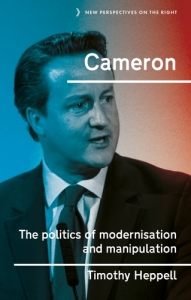
On the eve of the 2019 general election, almost the only certainty was that the outcome of the contest was unlikely to generate a revival of David Cameron’s reputation. Even the timing of the poll, which ensured that 2019’s ‘season of goodwill’ was arguably the least amicable in Britain’s post-war history, could be attributed to Cameron, since his Fixed-Term Parliaments Act denied Boris Johnson the chance of choosing an election date which would be less vexatious for Christmas shoppers.
Thus few Conservative activists are likely to include Timothy Heppell’s new study of Cameron’s leadership of his party and his country in their letters to Santa. However, the timing of its publication – hard on the heels of the appearance of Cameron’s memoir, For the Record – should have encouraged serious students of contemporary British politics to send a request for both books to Lapland. It would be a rare treat in any season to read and compare an exercise in self-justification with the careful scholarly analysis that Heppell provides.
Heppell organises his account of Cameron’s leadership (2005-16) around two main themes – ‘modernisation’ and ‘manipulation’. As the author points out, Conservative ‘modernisation’ under Cameron has been analysed by several scholars. But while Cameron’s attempt to ‘de-toxify’ his party is important, it is at least equally profitable to regard him as a manipulator of the broader political landscape – both before and after he became prime minister.
This is a very useful corrective to the previous literature on Cameron. Indeed, one might even wish that Heppell had pushed it further. From this perspective, it could appear that Cameron, and his key ally George Osborne, were preoccupied with the ‘modernisation’ of their party between the former’s rise to the Conservative leadership in 2005 and Gordon Brown’s fatal hesitation over the wisdom of calling a ‘snap’ election in the early Autumn of 2007. From that point until the election actually took place (May 2010), Cameron and Osborne sensed (rightly) that it would be easier to pursue a campaign of ‘delegitimisation’ against Labour than to persevere with the task of transforming their own party.
The sudden switch from a medium-term project of ‘detoxification’ to immediate electoral battle-readiness necessitated headline-grabbing genuflections towards right-wing voters – most notoriously, Osborne’s promise of Inheritance Tax ‘reforms’ at the 2007 Conservative Party conference – which ran the risk of undoing some of the modernising work. Yet it was a risk worth taking, since Osborne and Cameron had sought modernisation not for its own sake, but as the inescapable prelude to election victory. Now, thanks to Brown’s bungling, it suddenly looked as if their ultimate goal could be secured even if the Conservatives were less than fully refurbished. This is not to say that modernisation was abandoned completely, but rather that it became a secondary consideration and never regained Cameron’s full attention even after the election scare passed away.
Image Credit: Crop of ‘Prime Minister David Cameron, speaking at the opening of the GAVI Alliance immunisations pledging conference’ by Ben Fisher/GAVI Alliance courtesy of DFID – Uk Department for International Development, licensed under CC BY 2.0
On this view, the ill-fated Brown shares responsibility with Cameron for our current discontents. If Brown had decided to call a general election for October 2007 to capitalise on his honeymoon period (and without undertaking his much-criticised visit to British troops in Iraq), it is likely that Labour would have won, but with a reduced majority, which would have encouraged Conservatives to think that Cameron should be given another chance. This, after all, would have been a fourth successive defeat for the Conservatives – the same number of reverses which had made even sincere socialists succumb to Tony Blair in 1994, such was their desire to regain electoral bragging rights. Cameron would have drawn the (correct) lesson that his party could not be confident of victory unless he gave an additional push to modernisation – i.e. he would have been forced to accept that tokenistic gestures involving huskies and ‘hoodies’ were not enough to make Conservatives seem electable. Given their innate liking for tactical gambits, Cameron and Osborne would still have played blame games over public spending and MPs’ expenses; but they would have done so in the knowledge that Brown, now equipped with a UK-wide ‘mandate’ of sorts, could deny them a chance to unseat him until as late as 2012, so that ‘modernisation’ had the space to proceed in tandem with ‘manipulation’.
Dealing with realities rather than counter-factuals, Heppell shows that Cameron’s manipulation of the broader political debate had three objectives: making Labour seem culpable for the financial crisis which erupted almost as soon as Brown had decided to ‘bottle’ the snap election; staving off the challenge from the centre-left by endorsing as many Liberal Democrat policies as his party would allow him to get away with; and heading UKIP off at the pass by parading Eurosceptic credentials which he had borrowed for the purposes of winning his party’s leadership in 2005.
For Cameron, after the 2010 election it seemed that ‘manipulation’ had succeeded in a way which could make the incomplete project of Conservative ‘modernisation’ seem almost irrelevant. The Liberal Democrats had been increasingly sympathetic towards ‘Conservative’ economic principles at least since the publication of The Orange Book in 2004. Cameron’s ‘modernisation’ was essentially an attempt to move the Conservatives closer to the Liberal Democrat agenda on social issues. This ideological ‘convergence’ remained a work in progress in 2010, since many Conservative MPs and grassroots members retained the outlook which had earned them the reputation of ‘the nasty party’.
But Liberal Democratic leader Nick Clegg and his senior colleagues needed no convincing that Cameron and Osborne, at least, shared their social liberalism. By enlisting the Liberal Democrats into his coalition, Cameron had thus augmented the voting strength of the Conservative ‘modernisers’ in the House of Commons to the tune of 62 MPs. One might even say that, if all governments are essentially ‘coalitions’, the 2010-15 coalition was less like a coalition than any government since the days of Macmillan and Home. For Cameron, the parliamentary arithmetic of the 2010 general election apparently had produced a miraculous congruence between the twin aims of ‘modernisation’ and ‘manipulation’: hence, perhaps, the unmistakable aura of liberation which he exuded when celebrating the agreement with Clegg in the Downing Street garden.
In a sense, however, Cameron’s ‘manipulation’ strategy turned out to be his undoing. Although he had reached an ideological concordat with the Liberal Democrats, his commitment to political principle was never strong enough to overcome his tribal allegiance to his own party. Over issues like tuition fees and constitutional reform, he was either happy to let his coalition partners incur odium or to exploit their weaknesses in order to thwart their reformist proposals. In the 2015 general election the Conservatives duly seized 27 seats from the Liberal Democrats. If the party had exercised more mercy towards its coalition partner, it is possible that the Cameron-Clegg show could have been kept on the road, resulting (among other things) in a compromise around the 2010 Conservative policy of calling a referendum on any future EU treaty of constitutional significance, or perhaps a deal which gave Cameron time to call an ‘in-out’ referendum when he could feel more confident of securing the positive vote that he desired.
As it was, while Cameron’s ‘manipulation’ proved all too successful on his ‘left’ flank – saddling Labour with the blame for ‘austerity’ and ensuring that the Liberal Democrats looked like Conservative stooges – he never landed an effective blow against the hard right, within and outside his own party. Significantly, in 2006 when he thought that he was just beginning the arduous process of taking on the right, Cameron expressed the hope that Conservatives would ‘stop banging on about Europe’, but also took the risk of characterising UKIP members as mostly ‘fruitcakes’, ‘loonies’ and ‘closet racists’. Since these verbal volleys were just the opening shots of a campaign which he did not sustain, they left Cameron’s targets insulted and seriously annoyed, but uninjured.
Image Credit: Cropped image of ‘Lord Coe, Boris Johnson, David Cameron – World Economic Forum Annual Meeting 2012’ by World Economic Forum (photo by Moritz Hager), licensed under CC BY NC SA 2.0
It was not surprising, then, that having backed away from his looming confrontation with the right over Europe after 2006, Cameron was forced in January 2013 to promise an in-out referendum on EU membership. Significantly, the speech which announced this policy shift was delivered on the day before the first parliamentary reading of the Marriage (Same Sex Couples) Bill. In due course, this legislation would expose the extent of Cameron’s failure to modernise his party – or, according to taste, it demonstrated that the odds against a truly successful modernisation had been so steep that the whole exercise could never have been more than a public relations stunt. 136 Tory MPs voted against the second reading in February 2013, providing opportunists – even those whom he counted as close friends – to base their calculations of succeeding Cameron on the existence of an unreconcilable element within the party which would be only too glad to combine their distaste for social liberalism and fanatical loathing of the EU into an incendiary anti-modernising agenda. Thus the arch-manipulator found himself comprehensively out-manipulated by individuals who had no respect even for the (very) elastic boundaries of political respectability which were recognised by Cameron and Osborne.
Perhaps the best defence for Cameron, then, is that he was over-confident of his ability to build a ‘post-Thatcherite’ movement on the centre-right to match and mirror Blair’s New Labour, even after he had jettisoned long-term strategy in favour of tactical manoeuvres. Having taken control of his party, Blair destroyed his political career through maladroit decisions; Cameron made his share of mistakes (even, in the case of Libya, one which he could and should have avoided if he had clearly seen where his political role model had gone wrong), but given the incurable truculence of his party he could never have been more than a plausible frontman for the same old act. Amidst the unsightly wreckage there are some landmark reforms which could not have been achieved without him. Even so, a more resolute and principled politician than Cameron could surely have made a more concerted effort to make his party into a ‘hostile environment’ for extremists on a variety of issues, and to follow up on his attacks on UKIP with a series of thoughtful speeches on the pros and cons of EU membership, rather than saving up that material for the fateful Bloomberg speech of January 2013 which marked his capitulation to the demand of alleged ‘fruitcakes’ and ‘loonies’ for an in-out referendum.
Even if these reflections on Cameron’s political career are not set out explicitly in Heppell’s study, they seem to be implied. Heppell maintains an admirable tone of objectivity in a survey which demonstrates compendious reading of relevant sources, including the work of many authors who have written since Cameron’s ignominious departure from office. Ironically, Cameron’s successor, Theresa May – who had given her fellow Conservatives the bad news that they were regarded as ‘nasty’ – seemed to think that the process of ‘modernisation’ had succeeded already, and based her progressive and disastrous 2017 manifesto on that assumption. Johnson, by contrast, gives the impression of thinking that ‘modernisation’ will follow inexorably in the wake of successful ‘manipulation’ – Cameron’s original schedule in reverse. If Johnson really does end up as the leader of a Conservative Party that merits the ‘One Nation’ label, Cameron should be allotted a portion of the credit. However, at best he will be regarded as the inadequate instigator of the modernising process rather than a decisive actor – the ‘heir to Kinnock’, perhaps, not the ‘heir to Blair’. In other respects, even the manner of Cameron’s departure fell short of the standards required of a responsible political leader: his resignation statement was more a vindication of the decision to call the referendum than an analysis of the result, and he did more than anyone else to create the misleading impression that this outcome represented an unequivocal instruction to politicians. Thus, if British voters were ever asked to participate in a referendum on Cameron’s merits as a prime minister, there are good reasons to believe the negative verdict would be much more decisive than 48:52.
Note: This review gives the views of the author, and not the position of the LSE Review of Books blog, or of the London School of Economics and Political Science.


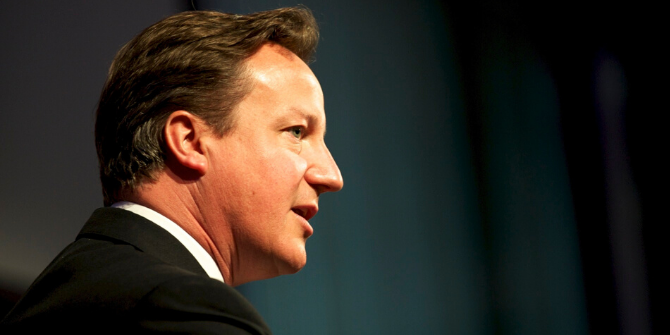
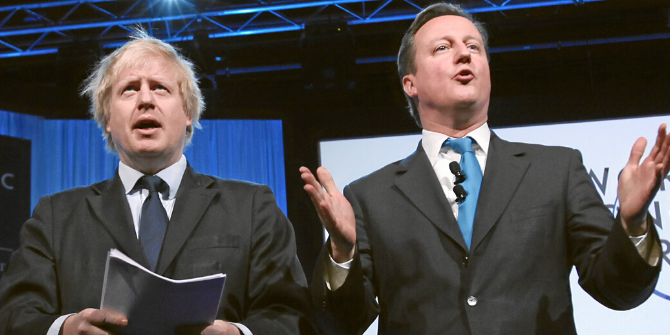



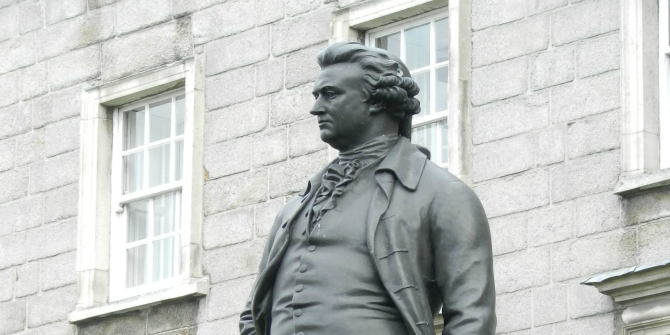
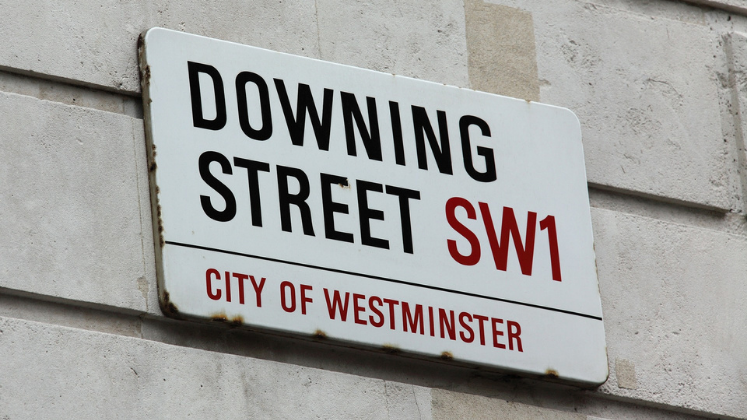

1 Comments